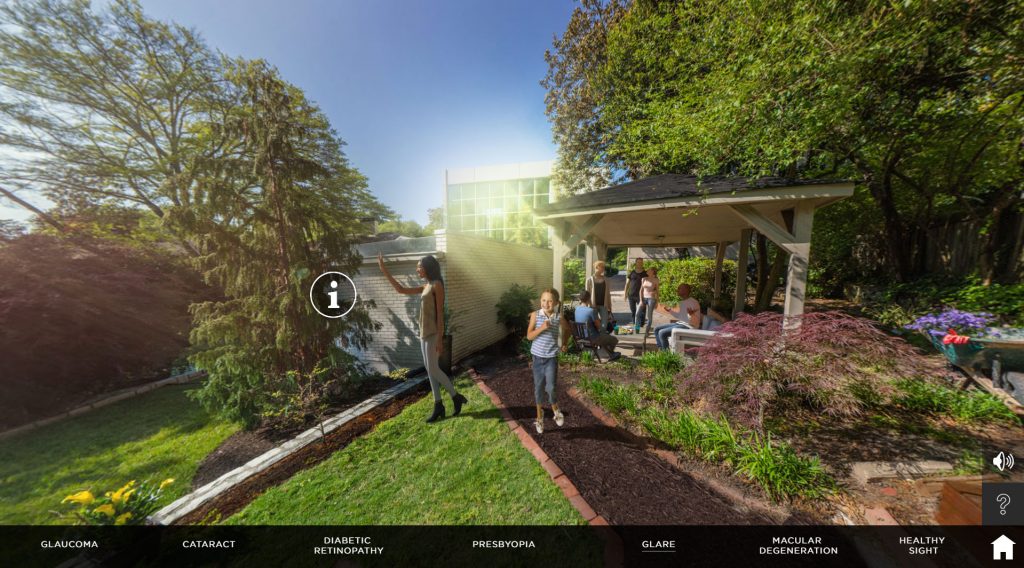Light is crucial for vision. It bounces off objects and enters your eyes, which allows you to see. But sometimes, it’s the source of vision problems, like glare.
The issue of glare is something most people deal with on a daily basis. From driving down a rainy highway late at night to trying to watch your favorite baseball team without squinting – the effects of glare can become an unpleasant and sometimes dangerous experience. On top of that, if you’re an eyeglass wearer the effects of glare can be even worse as they often become smudged or scratched. Regular eye exams from your eyecare professional can diagnose vision conditions that may heighten the effects of glare or provide solutions to glare – such as anti-reflective eyeglass coatings or Transitions® adaptive lenses.
What is glare?
Glare is the loss of visual performance or discomfort produced by an intensity of light in the visual field greater than the intensity of light to which the eyes are adapted. Simply put, glare occurs when too much light enters your eye and interferes with your eye’s ability to manage it. Glare can be distracting and even dangerous and can occur day or night in a number of ways. Glare may come directly from a light source or be reflected. There are four types of glare: Distracting glare, discomforting glare, disabling glare, and blinding glare.
- Distracting glare – Distracting glare results from light being reflected when it moves from one optical medium to another (e.g. from air to glass). This results in some of the light being reflected off the surface, or internally reflecting within a spectacle lens. Distracting glare comes from light reflected off the front of lenses so that others can’t see your eyes, and from light reflected off the backs of or within the lenses so that you see reflections in your lenses. This type of glare can also be experienced at night, forming “halos” around headlights or streetlights. Distracting glare can represent an annoyance or distraction to the viewer and lead to eye fatigue.
- Discomforting glare – Discomforting glare may result from direct or reflected glare and can be caused by everyday, bright sunlight conditions. Discomforting glare occurs in varying degrees of intensity, but even the milder degrees of discomforting glare result in visual discomfort, often shown by symptoms of eyestrain or fatigue. Depending upon one’s light sensitivity, this glare can also be discomforting regardless of weather or time of day. The unprotected eye will respond to discomforting glare by squinting and constriction of the pupil. It is common for the affected individual to try to avoid the glare by shielding the eyes or turning another direction.
- Disabling glare – Disabling glare, also known as veiling glare, is more intense than discomforting glare and the high level of light produces a glare that can actually interfere with or block vision. This type of glare comes from excessive, intense light that can occur when you face directly into the sun. Disabling glare causes objects to appear to have lower contrast than they would if there no glare. Disabling glare occurs because light scatters when it enters the eye, which, in turn, reduces the sharpness of vision and raises the differential light threshold. Disabling glare tends to become more problematic in the elderly, as the decreasing transparency of the crystalline lens that comes with age leads to developing cataract formation.
- Blinding glare – Blinding glare results from light reflecting off of smooth, shiny surfaces such as water, sand or snow. It can be strong enough to block vision. When the light reflects of the surfaces, it becomes polarized and produces blinding glare. Blinding glare can block vision to the extent that the wearer becomes visually compromised.
Glare tends to be worse with older age, light colored eyes, prior eye surgery, and certain eye conditions, including cataracts, dry eye and macular degeneration.
What is it like to see through the eyes of someone affected by glare?
As previously mentioned, glare can be described as “extreme brightness” from the presence of excessive visible light, and can cause discomfort and your vision to be compromised. The Vision Simulator shows users what it’s like to see through the eyes of someone affected by glare, and the types of everyday situations in which glare can occur. The Vision Simulator illustrates the effects of glare from the sun, but glare can be caused by artificial light sources as well. See the impact of glare by using the Vision Simulator: bcbsfepvision.com/visionsimulator.
What causes glare?
Glare is a common response to bright light, but can be a sign of cataract, macular degeneration or other eye diseases. Visiting an eyecare professional is recommended when glare interferes with your vision and quality of life. A professional eye exam is especially important to rule out the possibility of cataracts, which are strongly associated with glare and halo symptoms. Additionally, if you are an eyeglass wearer, your eyecare professional can provide you with lens options that can help minimize the effects of glare.
What optical solutions exist to reduce glare?
Several optical solutions exist that can help combat the effects of glare. One solution is an anti-reflective (AR) coating, which can be added to your prescription lenses and decreases reflected light and glare. Photochromic Transitions lenses, which adapt their level of tint based on how much UV is present, can also help reduce the effects of glare. Transitions lenses are also compatible with AR coatings, and perform even better when combined with AR. Transitions lenses with an AR coating blocks distracting, discomforting and disabling glare. For additional protection against blinding or reflected glare, Transitions® Vantage® lenses with variable polarization are a good solution. In addition to Transitions Vantage lenses, polarized sunglasses can also be used to eliminate blinding glare or the light off of flat surfaces like wet roads, water, and ice and snow.
Sight is precious; take care of your eyes with regular exams and proper eyewear.
Sources:
- http://global.transitions.com/TransitionsCanadaPro/White%20Papers/Beyond%2020-20%20Contrast%20Sensitivity,%20Glare,%20and%20Quality%20of%20Vision.pdf
- https://www.transitions.com/en-us/why-transitions/faqs/
- http://www.visionaware.org/info/everyday-living/home-modification-/lighting-and-glare/123
- https://www.visivite.com/glare-halo-condition.html


